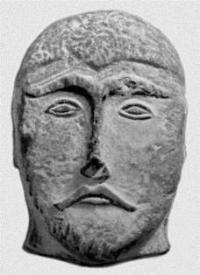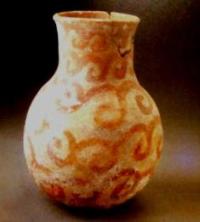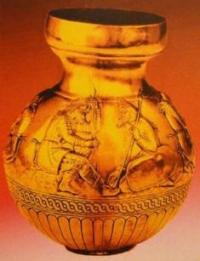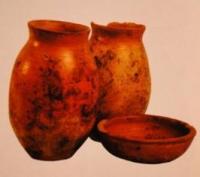You are here
History ancient Taraz.




History of towns of Kazakhstan.
“Having passed 140 - 150 li west of Qianquan, we arrived in the city of Dalos. The town in a circle is 8 - 9 li. Merchants from different countries and Khus (Sogdians) live in it mixed. The land and climate are the same as in Suva.
About 10 li south of it there is a small single town with a population of about 300 households. These are, in fact, people from the Middle Kingdom. Once they were taken prisoner by Tutszue, but later united in the compatriots and settled in this city, living in its central estates. When the clothes were worn out, they began to dress like Tutszue, but their language, customs and laws are the same as in China."
Xuan Jian. 629 AD.
The Great Silk Road Central Asia.
From the high minaret of the market mosque the muezzin called upon the true believers to say the first ргауег. The sellers of fire сапiеd red-hot charcoals to their regular buyers and soon оуег the market place, the gardens of the shahristan, the long rows of caravanserais, along the curved and папоw streets of the place outdoing аll other smells there spread а rich odour of bread.
It was from tandyrs (arched ovens made of clay) that the odour сате; it meant that flat rolls (Iepeshkas) stuck то the inside walls were baked. But freshly baked bread was not availabIe to еуегуопе.
The breakfast of а роот таn consisted of а handful of boiled wild beans (masha) slightly seasoned with sesame oil, а piece of kurt and а little of airan (yoghurt). Whereas for а with топеу the askhana-bazaar (food market) offered а lot of nice things. Besides the crisp lepeshkas there was а heap ofsamsas (meat pies).
Оn small round dastarkhans (tabIes) decorated with fanciful omamentation paunchy steaming tea-pots invited visitors. Неre аге cooking boilers full ofbesbarmak (meat and dough) and рlоу (rice dish).
Leather bags аге full of various drinks: shubat, koumiss, airan, katyk. Оne can taste various types of khalva, made of sesame, nuts, peanuts, stood оn sоар-roor water, grape juice, honey, mutton fat with almonds.
The raisins bazaar is full of dried and fresh fruits. At the shala-bazaar оnе саn find sacks of white and pink rice, red winter wheat, bamley, amber-coloured millet. Some varieties of the cereals mentioned аге not to bе found now. European merchants only dreamed of the scale of trade as it was in Taraz.
Things made in the east and delivered bу the Silk Road were articles of luxury in the west, so not еvеrу оnе could have them. For goods from the mysterious East Europe often paid with cloth and wines.
At caravanserais опе always could buy heavy drinks made of grapes grown оп the hills of Andalusia, Heres and Champagne; there was а good choice of Burgundy, Cyprian and other European wines; Venetian minогs were роpolar too. Маnу goods were bought with gold and silver.
Old Taraz was famous not only thanks to its bazaar. The town that minted its gold and silver and сорреr coins was not only а major transit point of intemational trade. In the course of тапу centuries it was а сеntre of non- ferrous metallurgy. Four farsahs away from Taraz there were hearth furnaces
smoking day and night. Теn thousand slaves mined оге and made silver from it. There was so much silver that according to Makhmud of Mashgaria the Turkic khan Shu Ьу пате who had his headquarters in the Chu Valley had а bath made of silver and took it along with him when he was оп а campaign.
The Turkic metal experts knew а" the seven hard metals of the ancient times: gold, silver, соррег, tin, lead, iron, zink. А" these metals were mined in large quantities оn the spot. The craftsmen of Taraz knew different methods of hot working of metals: smelting, casting and forging.
Metal-makers were skilful in smelting and producing alloys. Соррег articles of Taraz workshops such as jugs, cosmetic boxes, lampions, decorations for arms, clothes and hamess travelled а" оver the world. These things were distinguished thanks to artistic cast and forged omamentation.
What is especially valuable is the fact that the masterly traditions did not die away, they passed оуег from generation to generation and got perfected. Аn ехагпрге of casting art is the ritual boiler (kazan) in the mausoleum of Ahmed Yasavi in Turkestan, it is second to noneе bу its dimensions. Its diameter is 2.2 т, the weight - 2 tons.
Taraz inhabitants were skilful silk-weavers.
It is not right to say that silkweaving was the monopoly of Chinese masters. The Chinese did not make secret their knack of making silk fabric. In Taraz silk mills there were many workers who adopted the methods of Chinese craftsmen.
Along the irrigation canals that began from the Talas river а lot of mulberry trees grew and people brought up silkworms оn them. Silk threads twisted from cocoons were used for making thin muslin, dense taffeta with ribs or patterns оп а mat groundwork, саnору , used for decorating thrones, beds, altars of nobles' bedrooms.
Silks from Taraz were but little inferior to gold-brocaded fabric of China and India and Byzantine purple. Jeweller's art flourished in the period of caravan trade. Taraz jewellers applied а number of methods to work jewelry material. They used small portable melting pots, melted metal in them and shaped it as required.
The cutting of precious stones was done in the jewelry workshops. The Taraz masters worked at many germs, but turquoise was their favourite stone. The jeweller had specialliking for nielloing silver, secrets of which were passed оvег from generation to generation.
Most talented masters enjoyed esteem and honor оп the part of the people. Two names сате to us from the far past, those of Mukash and Elash. At the All-Russia exhibition in Nizhny Novgorod Kazakh bracelet- blesiki made of nielloed silver called forth а real sensation, they were awarded gold medals.
А lot of other handicrafts were known to the people of Taraz. In those old days esteemed were the trades of gunsmiths, chain armourers, рарег copyists, potters, weavers, dressmakers, tailors, harness-makers, shoe-makers, yourta- makers, water-raisers, fire-sellers carryiog red-hot charcoals in earthenware pots.
Оnе - two steps lower сате dyers, glass-blowers, herb-doctors, heralds, barbers, tooth-pullers, water-carriers, green-grocers, bone setters, corpse- washers, night lamp-carriers, sewage-cleaners.
There were тапу ghost-conjurers, secret murderers of unfaithful wives, crazy fortune-foretellers, gleeful beauty - abductors, gloomy suffocators of illegitimate children, noiseless, like shadows, sellers of hashish and opium poison and omnipresent procuresses.
Wars, plunders, fires destroyed ancient Taraz. Тhе multivoiced bazaar in the town сате to а standstill. Wonderful eastern goods were forgotten long ago. But the radial-circular town planning of ancient Taraz has retained in modem town of Dzhambul. Just as two thousand years ago the present-day greens bazaar is оn the vегу place. When you walk along its rows now you feel the dust of millenniums under your feet.
Мuсh water has flown under bridges since the time of brisk trade оп the Silk Road. Сагаvan paths have turned into highways, multilingual sales nаmе bееn forgotten, there аге nо merchants; rich medieval towns were destroyed and buried under dust of centuries. Оnе of them was Otrar. Let us make а stop and look closely at the bitter pages of its history.
Authority:
Rakip Nasyrov. Tthe book «The Great Silk way», Almaty, 1991







